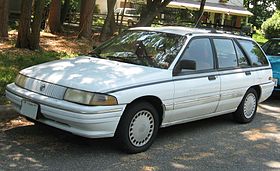Mercury Tracer
| Mercury Tracer | |
|---|---|

1993–1996 Mercury Tracer 4-door
|
|
| Overview | |
| Manufacturer |
Mazda (1987–1989) Mercury (Ford) (1990–1999) |
| Production | 1987–1989, 1990–1999 |
| Layout | FF layout |
| Chronology | |
| Predecessor | Mercury Lynx |
| Successor | Ford Focus (Mexico) |
| First generation | |
|---|---|
 |
|
| Overview | |
| Also called | Ford Laser (KC) |
| Production | 1987–1989 |
| Model years | 1988–1989 |
| Assembly |
Hermosillo, Mexico Taoyuan City, Taiwan Hiroshima, Japan |
| Body and chassis | |
| Class | Subcompact |
| Body style | 3-door hatchback 5-door hatchback 5-door station wagon |
| Related | Mazda 323 |
| Powertrain | |
| Engine | 1.6 L Mazda B6 I4 |
| Transmission | 5-speed manual 3-speed Mazda F3A automatic |
| Dimensions | |
| Wheelbase | 94.7 in (2,410 mm) |
| Length | Hatchback: 162.0 in (4,110 mm) Wagon: 169.7 in (4,310 mm) |
| Width | 65.2 in (1,660 mm) |
| Height | Hatchback: 53.0 in (1,350 mm) Wagon: 53.7 in (1,364 mm) |
| Second generation | |
|---|---|
 |
|
| Overview | |
| Production | 1990–1996 |
| Model years | 1991–1996 |
| Assembly | Hermosillo, Mexico |
| Body and chassis | |
| Class | Compact |
| Body style | 4-door sedan 5-door station wagon |
| Related |
Ford Escort Mazda 323 Mazda Protegé |
| Powertrain | |
| Engine | 1.9 L CVH I4 1.8 L Mazda BP I4 |
| Transmission | 5-speed M5 manual 4-speed F-4EAT automatic |
| Dimensions | |
| Wheelbase | 98.4 in (2500 mm) |
| Length | Wagon: 171.3 in (4,351 mm) Sedan: 170.9 in (4,341 mm) |
| Width | 66.7 in (1,690 mm) |
| Height | Wagon: 52.7 in (1,340 mm) Wagon: 53.6 in (1,361 mm) |
| Curb weight | 2498 lb (1133 kg) |
| Third generation | |
|---|---|
 |
|
| Overview | |
| Production | 1996–1999 |
| Model years | 1997–1999 |
| Assembly | Wayne, Michigan |
| Body and chassis | |
| Body style | 4-door sedan 5-door station wagon |
| Related |
Ford Escort Mazda Protegé |
| Powertrain | |
| Engine | 2.0 L SPI 2000 I4 |
| Transmission | 5-speed IB5 manual 4-speed F-4EAT automatic |
| Dimensions | |
| Wheelbase | 98.4 in (2,500 mm) |
| Length | Wagon: 172.7 in (4,387 mm) Sedan: 174.7 in (4,440 mm) |
| Width | 67.0 in (1,700 mm) |
| Height | Sedan: 53.3 in (1,350 mm) Wagon: 53.9 in (1,369 mm) |
The Mercury Tracer is a compact car that was marketed by Mercury from 1987 for the 1988 model year until 1999. The replacement for the Ford Escort-derived Lynx, the first generation of the Tracer was a modified version of the Asia-Pacific market Ford Laser, itself a variant of the Mazda 323. In 1990 for the 1991 model year, the Tracer became the Mercury counterpart of the Ford Escort in North America. All three generations of the Tracer were based on variations of the Mazda 323/Protegé.
The Ford Focus would serve as a common replacement for both the Ford Escort and the Mercury Tracer.
The Tracer was introduced in late 1987 as a 1988 model, replacing the Lynx in the United States and Canada. For the first time since the 1978 Capri II, the Mazda 323-based Tracer was a model unique to the Mercury division. Although derived from the Ford Laser sold in Asia and Australia, it was sold without a Ford counterpart in North America. As with its predecessor, the Tracer was sold in three-door and five-door hatchback body styles along with a five-door station wagon. The Tracer hatchback shared its body shell with the Ford Laser; while the station wagon was based loosely on the five-door hatchback, it was a distinct design.
The Mercury Tracer was assembled in a number of production facilities; the location was dependent on the body style and the country to which it was exported. Three-door hatchbacks for the US market were built alongside the Mazda 323 in Hiroshima, Japan, while five-door models were built in Mexico by Hermosillo Stamping & Assembly, where all station wagons were produced. For the Canadian market, both three and five-door hatchback models were built in Taiwan by Ford Lio Ho.
After skipping the 1990 model year, the Tracer returned in early 1990 as a 1991 model. While again based on the Mazda B platform, it now shared a body with the Ford Escort and the Mazda Protegé. The hatchback models were replaced by a four-door sedan; the five-door station wagon was carried over. The Tracer was sold in three trim levels: GS, LS, and LTS. The LTS was discontinued in 1993.
...
Wikipedia
